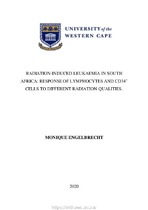| dc.description.abstract | Epidemiological studies have highlighted that leukaemia can be considered as the most prominent malignancy after radiation exposure during childhood. The lifetime risk on radiation-induced leukaemia for a given dose is 3 – 5 times higher for children compared to adults. The high risk at a young age is related to the elevated sensitivity of the red bone marrow where haematopoietic stem and progenitor cells (HSPCs) are located. HSPCs self-renewal capacity and long-life span increase their susceptibility to DNA damage accumulation, making them a major target of radiation-induced carcinogenesis. Proton beam therapy (PBT) is increasingly used to treat paediatric brain tumours due to its dose sparing properties compared to conventional X-ray based radiotherapy. However, concerns regarding the carcinogenic potential of secondary neutrons produced during PBT, especially in terms of their effect on HSPCs harboured in the cranial bone marrow of paediatric patients, remain. In this study, the radiobiological differences between 60Co γ-rays and p(66)/Be(40) neutron exposure was investigated to resolve the underlying mechanisms for the high radiosensitivity of HSPCs (CD34+ cells) isolated from umbilical cord blood (UCB). For both radiation qualities, an apparent dose-dependent increase in the frequency of radiation-induced MN was observed in CD34+ cells. Furthermore, increased cytogenetic damage was observed with the CBMN assay after neutron irradiation, which highlights its leukaemogenic potential. In addition, no difference was observed in the nuclear division index of the CD34+ cells post-irradiation between both radiation qualities. The number of DNA DSBs was assessed by microscopic scoring of γ-H2AX foci, 2 and 18 hours after radiation exposure. A significant higher number of DNA DSBs were observed 2 hours after neutron irradiation with 0.5 Gy, but decreased to similar levels for both radiation qualities after 18 hours. Different stages of apoptosis in CD34+ cells were studied at 18 and 42 hours numerous time points post-irradiation by flow cytometry using the Annexin/PI assay. In contrast to the γ-H2AX foci results, a significant difference in late apoptosis was observed at 18 hours and 42 hours between the two radiation qualities. The results point towards a fast error-prone DNA repair in HSPCs after neutron irradiation, which might contribute to genomic instability and leukemogenesis. In the second phase of the PhD project, the impact of age on radiosensitivity was investigated by comparing newborn T-lymphocytes with adult peripheral blood (APB) T-lymphocytes. The major difference between UCB and APB T-lymphocytes, is their immunophenotypic profile. Since it is known that different T-lymphocyte subsets have a difference in radiosensitivity, the fraction of CD4+, CD8+, naïve (CD45RA+) and memory (CD45RO+) T-lymphocytes was determined via flow cytometry in the two groups. The cytokinesis-block micronucleus (CBMN) assay was used to determine the extent to which age influences the frequency of cytogenic damage in response to 60Co γ-rays radiation. For both APB and UCB, an outspoken dose-dependent increase in the frequency of radiation-induced MN was observed at 0.5, 1, 3 and 4 Gy. However, no significant difference was observed at 4 Gy when comparing MN yields of APB and UCB. An increased radiosensitivity of newborn to adult donors of 34%, 42%, 29%, 26% and 16% was observed based on the MN scoring at doses of 0.5, 1, 2, 3 and 4 Gy, respectively. The lowest radiosensitivity was identified at the highest dose, which might explain the non-significant difference at 4 Gy. In addition, there was a clear trend that females were more sensitive to 60Co γ-rays radiation than males in both adults and newborns, even though the difference was not significant. The immunophenotypic study revealed that that both the CD4+ and CD8+ T-lymphocytes of newborns are mainly naïve. This is illustrated by the co-expression of CD45RA+ on 90.70% (range: 80.80% – 98.40%) and 95.90% (range: 89.60% – 98.80%) of CD4+ and CD8+ cells respectively. The composition of adult T-lymphocytes, in contrast, is clearly different with a more equal distribution between CD45RA+ and CD45RO+ subpopulations. This finding demonstrates that there are differences in the radiosensitivity between newborn and adult T-lymphocytes which might be linked to the immunophenotypic change of T-lymphocytes with age. | en_US |

